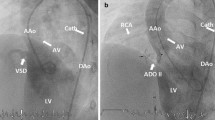Abstract
Different devices have been used for percutaneous closure of ventricular septal defects (VSDs). Over the past 6 months, we have used the Amplatzer duct occluder for VSDs associated with tunnel-shaped aneurysm in three patients here at our institution. Due to the anatomic resemblance between such VSDs and the duct occluder, we selected this device for percutaneous closure. There was trivial residual shunt in one patient. All three patients tolerated the procedure well and there were no untoward complications.



Similar content being viewed by others
References
Andersen HØ, de Leval MR, Tsang TV, Elliott MJ, Anderson RH, Cook AC (2006) Is complete heart block after surgical closure of ventricular septum defects still an issue? Ann Thorac Surg 82(3):948–956
Arora R, Trehan V, Thakur AK, Mehta V, Sengupta PP, Nigam M (2004) Transcatheter closure of congenital muscular ventricular septal defect. J Interv Cardiol 17(2):109–115
Arora R, Trehan V, Kumar A, Karla GS, Nigam M (2003) Transcatheter closure of congenital ventricular septal defects. Experience with various devices. J Interv Cardiol 16:83–91
Bass TA, et al. (2003) Initial human experience with the Amplatzer perimembranous ventricular septal occluder device. Catheter Cardiovasc Interv 58:238–245
Carminati M, Butera G, Chessa M, Drago M, Negura D, Piazza L (2005) Transcatheter closure of congenital ventricular septal defect with Amplatzer septal occluders. Am J Cardiol 961(12A):3
Fu YC, Bass J, Amin Z, Radtke W, Cheatham JP, Hellenbrand WE, Balzer D, Cao QL, Hijazi ZM (2006) Transcatheter closure of perimembranous ventricular septal defects using the new Amplatzer membranous VSD occluder: results of the U.S. phase I trial. J Am Coll Cardiol 47(2):319–325
Hardin JT, Muskett AD, Canter CE, Martin TC, Spray TL (1992) Primary surgical closure of large ventricular septal defects in small infants. Ann Thorac Surg 53(3):397–401
Hoffman JI, Kaplan S. (2002) The incidence of congenital heart disease. J Am Coll Cardiol 39(12):1890–1900
Holzer R, Balzer D, Cao QL, Lock K, Hijazi ZM (2004) Device closure of muscular ventricular septal defects using the Amplatzer muscular ventricular septal defect occluder: immediate and mid-term results of a U.S registry. J Am Coll Cardiol 43(7):1257–1263
Hu SS, Li SJ, Zhang H, Sun HS, Shen XD, Wang H, Jiang SL (2006) Effects of intraoperative hybrid procedures for the treatment of congenital heart disease. Zhonghua Xin Xue Guan Bing Za Zhi 34(3):236–239
Lock JE, Block PC, McKay RG, Baim DS, Keane JF (1988) Transcatheter closure of ventricular septal defects. Circulation 78:361–368
Nygren A, SunnegardhJ, Berggren H (2000) Preoperative evaluation and surgery in isolated ventricular septal defects: a 21 year perspective. Heart 83(2):198–204
Pedra CA, Pedra SR, Esteves CA, Pontes SC, Braga SL, Arrieta SR, Santana MV, Fontes VF, Masura J (2004) Percutaneous closure of perimembranous ventricular septal defects with the Amplatzer device. Technical and morphological considerations. Catheter Cardiovasc Interv 61:403–410
Pinto RJ, Dalvi BV, Sharma S (2006) Transcatheter closure of perimembranous ventricular septal defects using Amplatzer asymmetric ventricular septal defect occluder: Preliminary experience with 18-month follow up. Catheter Cardiovasc Interv 8 68(1):145–152
Sun XJ, Gao W, Zhou AQ, Yu ZQ, Li F, Huang MR, Sun K (2005) Risk factors for arrhythmia early after transcatheter closure of perimembranous ventricular septal defects. Zhonghua Er Ke Za Zhi 43(10):767–71
Tan CA, Levi DS, Moore JW (2005) Percutaneous Closure of Perimembranous Ventricular Septal Defect Associated With a Ventricular Septal Aneurysm Using the Amplatzer Ductal Occluder. Cather Cardivasc Interv 66(3):427–31
Walsh MA, Bialkowski J, Szkutnik M, Pawelec-Wojtalik M, Bobkowski W, Walsh KP (2006) Atrioventricular block following transcatheter closure of perimembranous ventricular septal defects. Heart 92:1295–1297
Weidman WH, Blount SG Jr, DuShane JW, Gersony WM, Hayes CJ, Nadas AS (1977) Clinical course in ventricular septal defect. Circulation 56 (Suppl 1):I56–I69
Author information
Authors and Affiliations
Corresponding author
Rights and permissions
About this article
Cite this article
Dilawar, M., Numan, M., El-Sisi, A. et al. Percutaneous Closure of Ventricular Septal Defect Associated with Tunnel-Shaped Aneurysm Using the Amplatzer Duct Occluder. Pediatr Cardiol 29, 366–370 (2008). https://doi.org/10.1007/s00246-007-9092-0
Received:
Revised:
Accepted:
Published:
Issue Date:
DOI: https://doi.org/10.1007/s00246-007-9092-0




